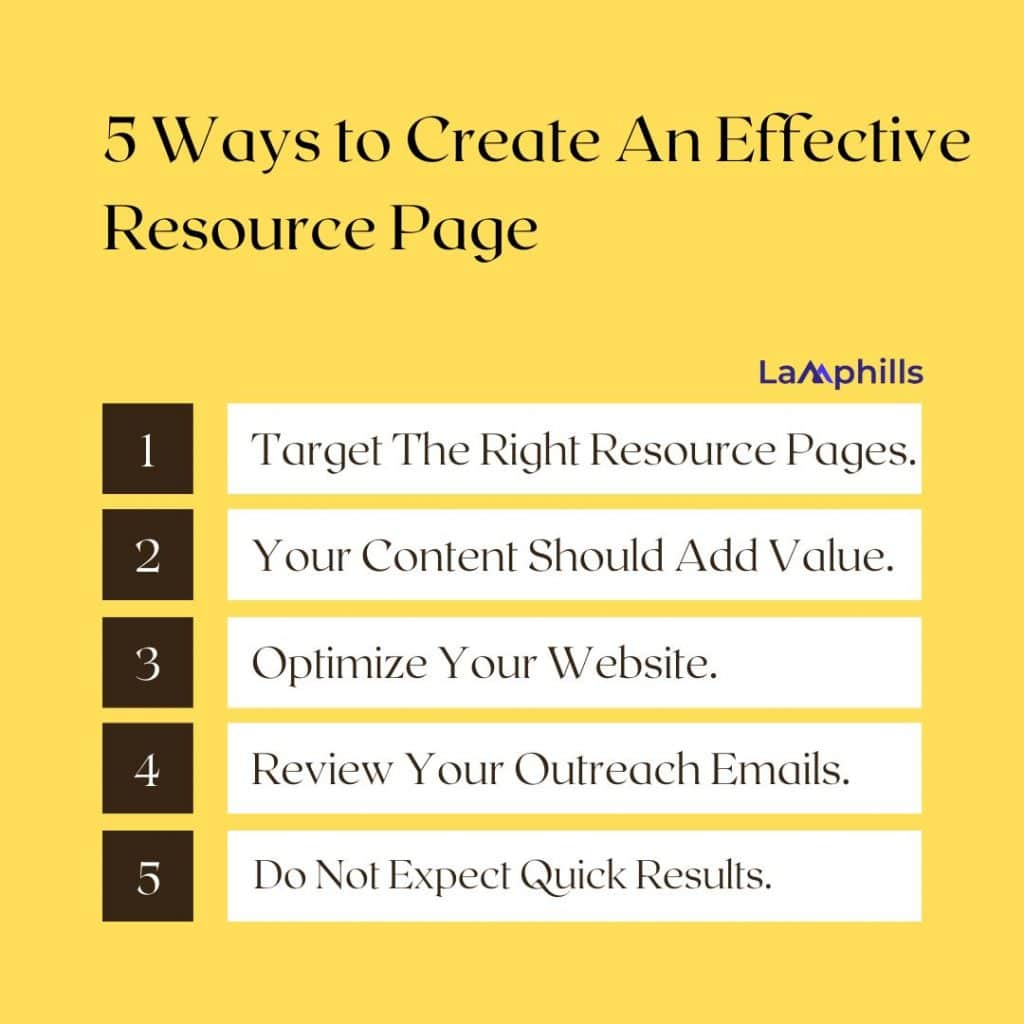Resource page link development is a link-building strategy that has a greater likelihood of success than any other. Resource pages are simple to locate, and website owners are eager to link to you, in contrast to other link-building strategies.
In this post, I will show you what a resource page is and how to develop high-quality backlinks from resource pages step-by-step.
Key Points
- Resource pages are excellent targets for link building since they are hubs that connect to excellent material on particular subjects.
- If your material is useful and pertinent to their audience, website owners will frequently link to your website.
- There are several efficient approaches to locating resource page link-building opportunities, including using Google search strings, reverse engineering competitors’ links and broken link-building.
- Outreach emails have to be customized and show the audience on the resource pages how your material benefits them.
- Building links to resource pages takes time, so it’s critical to be persistent and patient when working on the project.
What Is A Resource Page?
Resource pages are web pages that act as central points to connect links to other excellent content related to a particular subject. These pages offer great opportunities for link building because their primary purpose is to provide links to other websites.
Typically, resource pages include links to:
- Articles and blogs
- Podcasts
- Videos
- Tools
- Calculators
- Infographics
- Forums or communities
- How-to guides
Note that you receive a backlink and assist the website owner in maintaining the page’s relevancy and updates when a resource page connects to your content. It’s a mutually beneficial arrangement, and many resource page developers actively look for suggestions to improve their sites.
What Is Resource Page Link Building All About?
Resource page link building is the only procedure to get your website listed as one of the resources on the page. It’s your responsibility to inform the website owner about the existence of your resource, as they may not be aware of it!
What Are The Benefits Of Resource Pages?
Here are the advantages of creating a robust resource page:
#1. It Amplifies The Credibility Of Your Site.
By meeting every demand of your customer base, the resources page enhances the legitimacy of your website. As you provide your customers with the information they require to make judgments about what to buy and to make the most of your offerings, search engines start to regard your website as a reliable source of information. Your SEO components will be able to better attract new people to your website with this boost in reputation, and your valuable resources will entice existing visitors to return.
#2. It Improves The Customer Experience
Google always prioritizes a better user experience. As you refine your content to meet the needs of your audience, Google favors your platform. All of this is brought together with a resources page, which guarantees that your website can provide comprehensive answers to all industry queries and improve the user experience above that of your rivals. When they require information, your clients will come to your website first, increasing website traffic and brand engagement. Additionally, search engines will still direct people to you even if they don’t.
#3. It Develops Brand Loyalty And Trust
By creating resource pages, you can establish your company as a thought leader in the field and establish your website as the authority on material pertaining to your specialty. Visitors to your website are more likely to resort to your brand when they require information unique to your industry once they realize this relationship.
Additionally, their confidence in your information will eventually translate to your goods and services as well. This encourages people to turn to your business whenever they need assistance, which helps to increase brand loyalty.
How to Create a Resources Page Link Building
Here is a simple, three-step method for establishing links to your resource page.
#1. Find The Resource Pages
A straightforward Google search will yield the most direct and easiest way to locate resource pages. The beautiful thing about resource pages is that they are really easy to find.
You can utilize a range of search combinations while doing your searches.
i. Combinations pairing your desired keyword with the words “resources” and “links”
These search terms will return results that include your keyword along with the terms resources and links.
- Keyword + “resources”
- Keyword + “useful resources”
- Keyword + “helpful resources
- Keyword + “links”
- Keyword + “useful links”
- Keyword + “helpful links”
So if I were running a scholarship blog, I would search for scholarship + “resources”
Google will show you pages containing scholarship resources.
ii. Combinations that filter based on URL and title
You’ll see that the terms “links” and “resources” appear frequently in both the title and the URL of resource pages. You can focus on search results that only have these terms in the title or URL by using the following search terms:
- Keyword + inurl:resources
- Keyword + intitle:resources
- Keyword + inurl:links
- Keyword + intitle:links
#2. Narrow Down The Results
If you conduct the several searches mentioned above, thousands of resource pages should come up. Finding those that are reliable, and high-quality is your current task.
Prioritize the page authority over the domain authority when making that decision. The page authority reveals the level of authority associated with that particular resource page. The amount of “link juice” that flows to your website increases with page authority.
You do not have to guess which websites have more domain authority when you can use MozBar to view all the metrics directly on the search results page.
By using this information, you may focus on the pages that are most valuable and spend less time on pages that have low domain authority (DA) and page authority (PA).
#3. Reach Out
There may be a statement on resource pages asking you to email them with other pertinent resources. They might even include a form for submitting resources right on the page. If you can’t find this, it just means that you need to find an email to contact them.
Here are some suggestions about when to get in touch.
i. Verify that your resource is a suitable match.
You must ask yourself if the audience for that page is interested in your content.
There’s a strong possibility that a resource page that only includes links to fashion content, for instance, won’t link to your pet blog.
ii. Do your research if you are working with big websites.
You wouldn’t just contact anyone at Investopedia. It would require some research to identify the appropriate individual to get in touch with regarding that specific resource page.
Once you know this, you could find out who the writer is and send them an email asking to be included on the resource page. Always email the message directly to someone, if at all possible.
iii. Ask nicely.
Send a kind, courteous request if you’re sure your resource page is a suitable fit and you’ve identified the appropriate individual to get in touch with.
Try stating anything along these lines.
Hello, [first name]
I discovered you had [this fantastic resource page on your website] when conducting some research on [subject]. Fantastic work!
You seem to be an authority on the topic, therefore, I thought you might be interested in reading my piece on [topic]. It would be a fantastic addition to your resource page because it is so detailed.
If you would like to have a look, here is the link:
[Link]
Regards,
Philips
Examples of Resource Pages
#1. Dribble Resource Page
Dribble contains one of the better examples of a resource page for a website. Additionally, it is a great illustration of a resource page that is both valuable and well-designed. It is a well-liked community for designers. It has put together a list of tools to help and motivate its users.
Features of Dribble’s resources are:
- High-quality posts can be found on Dribble’s blog page. Freebies and design systems are created. It provides ready-to-use resources that designers can apply to their work.
- Dribble updates the resource page with fresh content and keeps the old resources up-to-date. Designers can always find the newest tools, trends, and techniques with this.
- Dribble promotes community involvement by showcasing user-generated content. This strategy encourages teamwork. It gives designers a platform to exhibit and get recognition for their work. Furthermore, it fosters the expansion of the design community.
#2. Bynder Resource Page
The Bynder Resource Page is among the top resources out there. It’s an extensive and user-friendly platform. The page provides a plethora of resources, tools, and information to help people with their marketing initiatives.
The following are features of the Bynder Resource Page:
- The Bynder Resource Page has a ton of information. Digital asset management, brand management, marketing, and design are all mentioned in the material.
- It provides e-books, whitepapers, and in-depth articles. It also includes a knowledge repository with information on a variety of subjects. In order to provide better learning, it also includes links to other reliable websites. Its large collection guarantees that consumers will obtain insightful information.
- The platform’s design prioritizes the user’s experience. It provides a simple and easy-to-use interface. Users can move between sections.
- The simplified design guarantees effective retrieval of information and improves usability.
- Bynder Resource Page worked with professionals in the field to create excellent content. By doing this, customers are guaranteed access to accurate and current information from reputable sources.
- The Bynder Resource Page provides useful templates and resources. These are tools that users can utilize in their daily lives. These tools aid in increasing productivity and streamlining procedures.
- The Bynder Resource Page is regularly updated with new content. It makes sure users are up to date on the newest tactics, methods, and technological advancements.
- By creating individualized accounts on the Bynder Resource Page, individuals can tailor their experience. Users have the option to bookmark articles for later reading and keep their favorite resources. The ability to customize improves user engagement. It guarantees that people can obtain the information that is most pertinent to them.
#3. HubSpot Resource Page
HubSpot Resource Page is a platform for business owners, salespeople, and marketers. It provides an extensive collection of tools, resources, and instructional materials.
This page supports firms and people in their marketing and sales endeavors. The following factors make the page stand out:
- The HubSpot Resource Page offers a vast array of material. Topics including customer service, sales, marketing, and corporate expansion are covered.
- Articles, blog entries, e-books, templates, services, and courses are all included. The abundance of resources guarantees that users will discover insightful information. Creating a resource page will help you get greater visibility in search engine results.
- The platform’s interface is easy to use. It makes content discovery and navigation simple. Finding the needed information is simple thanks to the search tool and the layout’s easy design.
- The HubSpot Resource Page provides a number of useful templates and resources. Processes for sales and marketing are made more efficient. These include analytics dashboards, social media scheduling tools, and email templates. Moreover, it includes more than just customer relationship management (CRM) software.
- The content on the HubSpot Resource Page has been updated. It guarantees that users remain up to date on the newest developments in sales and marketing. In order to support their achievement, this commitment guarantees that users have access to current information.
- This community’s interactive element enhances the user experience. It also promotes cooperation and knowledge exchange.
- The HubSpot Resource Page is compatible with more HubSpot services and products. It unifies the ecosystem around sales and marketing initiatives.
- The filtering options and a search box on the website enable users to locate particular materials or subjects that pique their attention.
5 Ways to Create An Effective Resource Page for Link-Building

If you want to get the best results from your resource page link-building, it’s time to reassess your approach. Here are some key areas where you should look:
#1. You Should Target The Right Resource Pages.
One of the causes of unsuccessful link-building is attempting to connect with outdated pages. Therefore, make sure the pages you are targeting are up-to-date and relevant to your content. No matter how important your link may be, website owners with out-of-date or irrelevant sites are unlikely to link to your content or draw a lot of traffic.
#2. Your Content Should Add Value.
To determine whether the target sites and their readers actually benefit from your material, consider the following important questions:
- Does the content touch on subjects that the readership finds interesting?
- Does the stuff already included in the links seem too similar?
- Is the text readable, visually appealing, and well-written?
- Does the content exhibit knowledge, credibility, and reliability?
Additionally, you should try out a variety of content formats, such as case studies, infographics, and videos, to evaluate which ones work best.
#3. Optimize Your Website.
Website owners might not want to link to your website if it is poorly optimized or operates slowly.
The following are some things to consider:
- Is it simple to use your website?
- Does the page load quickly on your website?
- Is your website mobile-friendly?
- Are your design and content enticing and easy to use?
#4. Review Your Outreach Emails.
Examine your outreach emails for a moment. Do they feel like generic spam, or are they individualized and professional? Instead of using generic templates, create messages that are specific to each person.
Additionally, make sure the receiver understands the value of your information for both themselves and their audience. Make it obvious why they should be interested in what you have to offer and emphasize its significance.
Finally, never hesitate to courteously follow up with people who haven’t replied. A small prod here and there can result in a well-placed link.
You can make use of our outreach email template to reach out to other website owners:
#5. Do Not Expect Quick Results.
Although it’s normal to want to see results right away, patience is essential when creating resource links.
Note that results from resource link building take time to manifest. Generally, it may take anywhere from three to twelve months for your search rankings and organic traffic to start improving.
What Is The Content Of A Resource Page?
The content of a resource page includes connections to products, services, publications, tools, apps, and websites that your readers would find valuable.
Additionally, this page may also be referred to as a “toolbox” for a brand, a “recommended tools” page, or an affiliate links page.
Read Also: Discover the Secrets to Crafting Unique Contents in 2024
How do I Find Resource Pages?
While there are other methods for locating pertinent resource pages, Google search is the most widely used. These are essentially sophisticated search modifiers that let you retrieve a particular collection of Google results. You can utilize the following search operator examples: carrots inurl:links intitle:resources.
What Is The Difference Between A Resource Page And A Blog?
The primary distinction between a blog and a resource section is that, while blog posts primarily consist of short-form content that isn’t always evergreen, resource pages have more in-depth “resources” and tools that serve specific purposes. Your resource page is a catalog if your blog is a pamphlet.
Why Is It Called A Resource Page?
It is called a resource page or a knowledge center because it is where you can delve deeper into a certain subject. A resource page’s material is typically longer and more in-depth than that of a typical blog post; it may also contain far more words.
Related Articles:
What Is Link Farming and Why Is It Considered a Black Hat SEO Tactic?
SEO Outreach Explained: A Beginner’s Guide to Getting Quality Backlinks
Backlink Outreach: Meaning, Types & How to Build a Successful One
Harnessing the True Potential of Backlinks for Business Growth: The Backbone of SEO






